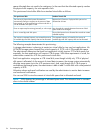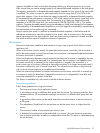Minimizing snapclone workloads
A snapclone copies the entire source disk without stopping. However, creating a snapclone creates
an additional workload on the snapclone's disk group while the data is being copied. You may
observe an increase in command response time and a decrease in the disk group's maximum I/O
during the copy operation. This performance impact ceases when the copy operation completes.
For optimum snapclone performance:
• Create snapclones during low-demand periods.
• Keep virtual disks as small as possible.
• Minimize the number of concurrent snapclone operations (use fewer virtual disks).
• Organize clone operations into consistency groups of virtual disks, and then clone consistency
groups sequentially. In an EVA storage system, a consistency group is a collection of related
virtual disks against which operations should be performed together (consistently).
Minimizing the number of snapshots
Snapshots copy point-in-time data as it changes on the source disk. The performance impact is less
than for snapclones. For many applications, less than 10% of the data on a virtual disk changes
over the life of the snapshot. When this 10% has been copied, the performance impact ceases.
Also, in typical workloads, the performance impact decreases exponentially over time as the source
and snapshot virtual disks diverge. In other words, the performance impact is greater on a new
snapshot than on an old snapshot and, unlike snapclones, occurs during the host write operation.
For optimum snapshot performance:
• Minimize the number of virtual disks with snapshot copies. Use fewer virtual disks; it is better
to have a few large virtual disks than many small virtual disks.
• Minimize the number of snapshots for a virtual disk. For capacity considerations, do not keep
extra snapshots.
• Minimize the life of a snapshot. If snapshot copies are used for backup, consider deleting the
snapshot after saving the copy on tape.
• Delete snapshots in age order, oldest first.
Setting virtual disk cache to write-through before a snapshot or snapclone
The array automatically flushes the write cache before copying data to a snapclone or snapshot.
You can reduce the performance impact of creating a snapshot or snapclone by presetting the
write cache on the source disk to write-through mode. The performance benefit is greatest when
there are multiple snapshots or snapclones for a single source disk. Be sure to re-enable write
caching after the copy is initiated.
Suspending a DR group before a making a snapshot of a virtual disk
In remote replication configurations, you can improve system performance by temporarily suspending
a DR group before creating a snapshot of the destination virtual disk.
The performance impact of an improperly sized (in a performance sense) snapshot or snapclone
can cause HP P6000 Continuous Access to suspend replication. System and application performance
and availability can be improved when replication is suspended as a planned event rather than
an unplanned disruption.
Minimizing simultaneous replication operations
Minimize the number of simultaneous local replication requests on the same array. Too many
simultaneous local replication events can reduce array performance.
Optimizing replication performance 41


















